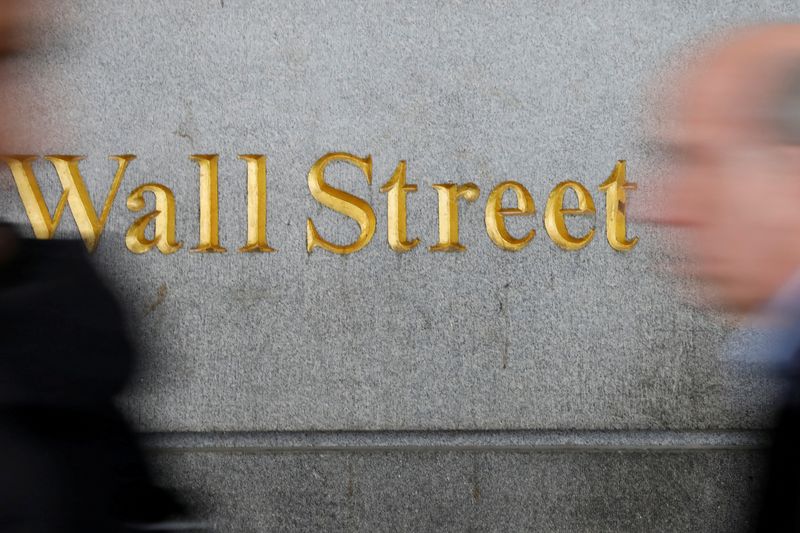By Saqib Iqbal Ahmed
(Reuters) - Investors are eyeing portfolio protection from a potentially rough stretch in U.S. stocks as they face political uncertainty, big tech earnings and seasonal weakness.
Excitement over advances in artificial intelligence and gradually cooling inflation have helped the S&P 500 rise nearly 17% this year. That gain has been accompanied by one of the most placid periods of trading in recent memory: the benchmark index has gone 355 sessions without a daily decline of 2% or more, the longest such stretch since 2007.
Bets in options markets show investors expect that calm to be tested in coming weeks. The Cboe Volatility Index, known as Wall Street’s fear gauge because it measures demand for protection against market swings, jumped to its highest level since late April last week following a selloff in technology stocks that dealt the S&P 500 its second largest weekly drop of 2024.
Though stocks rebounded on Monday, there are signs investors are growing increasingly concerned about everything from tech earnings to more twists and turns in the U.S. presidential election. Even artificial-intelligence darling Nvidia (NASDAQ:NVDA), which is up 138% this year, is being regarded with a comparative degree of caution. The ratio of puts-to-call options hit 0.74-to-1 on Friday, the most defensive it has been in about two months, according to Trade Alert data.
Meanwhile, VIX futures show investors are guarding against elevated volatility around the U.S. presidential vote in what has already been one of the most dramatic election years in history. President Joe Biden abandoned his failing reelection bid on Sunday under growing pressure from his fellow Democrats and endorsed Vice President Kamala Harris as the party's candidate to face Republican Donald Trump in November.
"We've seen people wake up to the fact that there's probably volatility coming," said Joe Tigay, portfolio manager for Rational Equity Armor Fund. However, "it doesn't seem like they've fully adjusted their positioning yet to be protected if it does."
One potential trigger for volatility could come as the tech and growth companies that have led markets higher report earnings, starting with heavyweights Tesla (NASDAQ:TSLA) and Alphabet (NASDAQ:GOOGL) on Tuesday afternoon.
Weaker-than-expected results could spur investors to pull money from the tech giants and pour it into areas of the market that have languished this year, furthering the so-called rotation trade that saw technology stocks fall and small caps and other laggards soar last week.
The small-company focused Russell 2000 is up 9% over the last 10 sessions, while the tech-heavy Nasdaq 100 is down 3% during that period, a trade spurred by rising expectations the Federal Reserve will soon cut interest rates and the improving political fortunes of GOP presidential candidate Donald Trump after he survived an assassination attempt.
Tech's dominance of markets this year, which has drawn comparisons to the ill-fated dotcom boom more than two decades ago, has sparked worries the trade has become vulnerable to selloffs, said Michael Thompson, co-portfolio manager at boutique investment firm Little Harbor Advisors.
"That mega cap-versus-everything else trade driven by the AI theme has been going on for a while,” said Thompson, whose funds have lately been taking profits on some of their positions. "The market in general felt like it had been … due for some mean reversion."
A combination of seasonality and election year jitters could be another catalyst for market gyrations, with September and October typically the most volatile months for U.S. stocks. The VIX averages 21.8 in October, compared to its closing level of 14.9 on Monday. That rises to 24.8 in election years, according to LSEG data going back to 1992.
October VIX futures, which also encompass the November vote, are trading at the highest level for any contract between August 2024 and January 2025.
Analysts at Deutsche Bank (ETR:DBKGn) said a tighter, less predictable race would likely increase uncertainty for markets and weigh on stocks.
Online betting site PredictIt on Monday showed pricing for a Donald Trump victory at 60 cents, compared to 39 cents for a win by Harris.
A major shift in the volatility regime could hurt investors who had piled into trades specifically aimed at market gyrations staying low. One of these is the so-called dispersion trade, in which investors seek to take advantage of the difference between index-level volatility and volatility in single stock options.

But such trades are unlikely to come unwound unless the VIX goes significantly above current levels, said Kris Sidial, co-chief investment officer of volatility arbitrage fund the Ambrus Group.
"Those knock-in levels exist more so in the high 20s of VIX," he said.